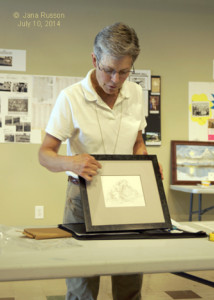Pointers for Preparing Artwork for Exhibition
Two-dimensional artwork can require matting, glass, and/or framing. Furthermore neat and appropriate hardware and wire is required to create “exhibition ready” artwork.
Matts keep glass from touching artwork and should NOT distract from the artwork.
- Best to use neutral colors: white, offwhite, grey, cream, occasionally black.
- Width should be in proportion to size of artwork—the smaller the artwork, the narrower the matt borders. Generally top and sides are uniform and bottom is slightly wider to give “weight” at the bottom which is pleasing to the eye.
example: An 8 x 10 artwork could have 2 inch matt borders on top and sides and 2 1/4 inch on bottom.
Glazing: clear, anti-reflective, or non-glare (also called reflection control)
- Glazing protects the artwork from dust, stains, and projectiles.
- Paintings, charcoals, sketches and drawings use clear and anti-reflective glass.
- Photography often uses non-glare when no matts are used and photo is sprayed to keep glass from sticking to photo. (Non-glare distorts as artwork distance increases should not be used with a shadow box or artwork with double or triple matt.)
Frames are used to embellish as well as protect the artwork and, of course make hanging easier.
- The focus should be on the artwork and not the frame. Neutral colors. If used along with matts, consider the matt and frame as a combined unit to determine how wide it should be. Use plain frame rather than fancy. Like the matt, the frame should NOT distract from the artwork.
Always use screw eyes, D-rings, or similar hardware with wire for hanging artwork. Sawtooth hangers are problematic. Mount hardware 1/3 distance from the top of frame. Wire should arch to 2 inches below the top of the frame, or halfway between the hardware and the top of the frame for smaller pictures.
Bumpers should be used at the bottom corners of the frame to keep the frame slightly off the wall. Bumpers are a usually round, self-stick, felt pieces.
Label the artwork on the back with your name, name of the artwork, price of the art. If you have a business card, this often works well to tape onto the back.
For 3-dimensional artwork, the pedestal should likewise not distract from the work AND it should be safe and secure.


reworked from Ann Salviazul’s 2014 presentation
Presented by Gigi Wahba, March 2016, and Ann Salviazul, 2014
Photos by Jana Russon, 2014
Revised May 2016